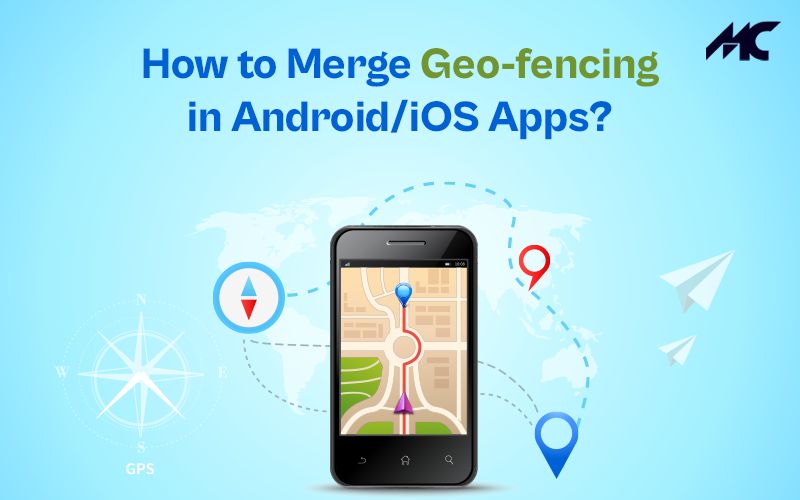Geo-fencing is a location-based technology that gives immense benefits to businesses. It enables local service providers to target mobile users in a defined geographical location for various marketing purposes. But it is not restricted to business only, geo-fencing is meant for all.
But when it comes to using geofencing it is not as easy as one may think. There is a certain technical process to accurately implement this location-based technology on mobile devices.
You even have to take assistance from an iOS or Android App Development Company to successfully integrate geofencing in your Android or iOS app respectively.
If you need assistance in this, then here in this article, we will guide you on how to do it perfectly.
What is Geo-fencing?
Geo-fencing is a location-based technology. It basically works like an invisible fence around real-life geographic areas. When any geo-location-supported smartphone or any mobile device enters this geo-fenced region, it automatically triggers a response.
For example, when a shopper who uses an eCommerce mobile app of a nearby local store, comes inside the geo-fencing area, it triggers a push notification to the app owner. With this technology, shopping stores can send instant push notifications and exclusive deals and offers to the user’s device using geolocation technology.
What is a Geo-fencing app?
A geo-fencing or geo-location mobile app allows you to define or specify a virtual fence around a geographical area. This app enables users to utilize geo-location features for various purposes like time tracking, location tracking, vehicle tracking, law enforcement, child location monitoring, and more. Android and iOS both OS platforms support geofencing in their mobile app ecosystem. But they have different procedures to use this technology on their mobile devices.
Common Use Cases of Geo-fencing
Geo-location is a highly useful technology. There are many ways people use geo-fencing for various purposes. Below is the listed common use case where geo-fencing is used:
1. Proximity marketing
Geo-fencing apps are used for Proximity marketing. It allows businesses like retailers, local stores, and offline shopping centers to send promotional messages to their potential customers who are nearby the store location.
2. Crowd management
Geofencing apps are highly useful in crowd management. This enables the management team to monitor the movement based on this current location and timely and accurately manage the crow.
3. Social Networking
In social media, it lets users find out relevant content based on location-based filters. Users can discover specific content based on location for sharing on other social media platforms.
4. Supply chain & logistics
Geo-location mobile apps work like a lifeline in supply chain & logistics. It is used for ascertaining shipping and delivery locations and defining routes or virtual regions on the map. Besides this, geo-fencing also assists supply chain and logistics companies in monitoring off-site staff and in-house workforce management.
How Does Geofencing Work?
The core functioning of geofencing apps relies on the location of devices. It primarily utilizes a mobile network, or WiFi, and GPS for fetching and processing location-based data. When a user with a geo-location enabled mobile device enters the geo-fenced location the GPS technology captures the device ID of the user.
Users then open up a browser or app on their device and they receive messages from the admin of the geofenced geographical area. In this process, the admin of the geo-fencing area is able to send promotional offers and messages to the user’s device through geo-fencing mobile apps.
How to Add Geofencing in Android/iOS?
Integrating geofencing technology is a completely technical process. First, you need a ready-to-use geo-fencing app to utilize its features on Android and iOS mobile devices respectively. Android and iOS have different ecosystems and technical requirements for integrating geo-location technology.
For this, you might have to take assistance from an Android or iOS App Development Company as per your device type. However, in order to integrate geofencing technology in Android or iOS devices, you need to follow the below simple steps-
- Decide whether to purchase a ready-made app or build an entirely new one
- Choose a geofencing SDK dedicatedly for Android and iOS.
- Add APIs (if required)
- Get the full-functional geofencing app
- Link accounts in your device
- Add geofences
- Create geofence objects
- Set the target for geofence transitions
- Define the geofenced zone or area
Conclusion
Geo-fencing is an extremely useful location-based technology for businesses as well as consumers. Businesses use it for marketing purposes and consumers use it for security and routine activities. There are many geo-fencing apps available on the Play Store.
But, in case, if you need a custom geo-fencing app specifically for your business, then you should find a Professional Mobile App Development Company. And luckily, MobileCoderz is one of the top companies which is specialized in developing location-based mobile apps. Contact them and they will build you a top-notch geo-fencing app for your business purpose.


